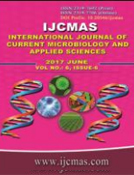


 National Academy of Agricultural Sciences (NAAS)
National Academy of Agricultural Sciences (NAAS)

|
PRINT ISSN : 2319-7692
Online ISSN : 2319-7706 Issues : 12 per year Publisher : Excellent Publishers Email : editorijcmas@gmail.com / submit@ijcmas.com Editor-in-chief: Dr.M.Prakash Index Copernicus ICV 2018: 95.39 NAAS RATING 2020: 5.38 |
Present analysis was carried out for two different period’s i.e., pre global warming period (1931-1970) and post global warming period (1971-2010) to find out the changes in seasonal and annual rainfall of 17 districts of Chhattisgarh. Results revealed that there are changes in monthly and seasonal rainfall distribution in different districts between pre and post global warming period. When the per cent deviation was examined there was 35% decline in annual rainfall in Mahasamund followed by Raigarh (29%) and least decrease was observed at Bastar (6%) followed by Korba (7%). Variability in annual rainfall during pre and post global warming periods indicated that the highest increase in CV was noticed in Raigarh district where the CV increased from 18 per cent to 30 per cent during post global warming period and in Rajanandgaon CV decreased from 29 to 22% during post global warming period. From the analysis of suitability of rice cultivation under rainfed condition based on the distribution of rainfall that during post global warming none of the districts was highly suitable for rainfed rice cultivation. The worst affected district is Mahasamund followed by Raigarh and Narayanpur. These districts came under category 1 (highly suitable for rainfed rice cultivation) during pre-global warming period and during post global warming period rainfed rice cultivation no longer suitable. Immediate crop diversification with other suitable crops (less water requirement and short duration) in lieu of rainfed rice and also popularizing water/soil conservation technology like On Farm Reservoir (OFR) and System of Rice Intensification (SRI) should be taken in order to avoid further degradation of ecosystem.
 |
 |
 |
 |
 |